& Construction

Integrated BIM tools, including Revit, AutoCAD, and Civil 3D
& Manufacturing

Professional CAD/CAM tools built on Inventor and AutoCAD

Integrated BIM tools, including Revit, AutoCAD, and Civil 3D

Professional CAD/CAM tools built on Inventor and AutoCAD
Use various graphing tools to view and analyze your simulation results.
Type:
Tutorial
Length:
9 min.
Tutorial resources
These downloadable resources will be used to complete this tutorial:
Transcript
00:04
When working with simulation results, the graphing tools in InfoWorks ICM offer various ways to view and analyze results.
00:13
Graphs are also useful to present data to colleagues, clients, and other stakeholders.
00:19
In this exercise, you use various graphing tools to view and analyze your simulation results.
00:25
To begin, copy the data out of the transportable database .icmt file for this tutorial,
00:33
and double-click the Design Run simulation to open it in the GeoPlan.
00:40
Start by graphing a single node in your simulation results.
00:44
Click the Find in GeoPlan tool and perform a Quick Find for node TF91296202.
00:55
Click the Graph tool, then click the selected node.
00:60
If you see a Multiple Selection popup, choose the first node, and then click OK.
01:05
In the Graph dialog, select the attribute to graph in the list of node-specific parameters.
01:12
You can choose multiple properties to graph, but for this example, select Level, and then click OK.
01:20
The graph appears, displaying level properties of the node throughout the replay results.
01:25
Notice the Ground Level line.
01:28
Anything above this line indicates flooding.
01:31
Close the graph, and then click Clear selection to clear any active selections in the model.
01:37
You can also graph several objects at once.
01:40
Select multiple elements in the model, and then click the Graph selected objects tool.
01:47
In the Graph Selection dialog, select what to view in the results graph.
01:52
For example, in the Left section, select Nodes, and the Level attribute.
01:59
In the Right section, select Links and the Flow attribute.
02:04
Click OK to graph this multi-selection.
02:08
Right click the graph to see additional options such as export to csv.
02:14
When you are finished exploring, close the graph, and then click Clear selection.
02:20
A graph report is a more advanced form of graphing and allows you to compare results,
02:26
either from multiple locations or from multiple simulations.
02:31
Click the Find in GeoPlan tool and perform a Quick Find for link TF92292302.1.
02:41
Click the Trace and select links upstream tool, and then click the selected link.
02:49
From the Results menu, select Graph Reports > Location Report.
02:57
A Locations popup appears, displaying the selected simulation and selection list.
03:03
This window allows you to change these locations, but for this example, leave them as is, and click Produce Graphs.
03:12
In the Parameter Selection dialog, select Link as the Location, and in the Parameters section, select Flow.
03:20
Click OK and close the Locations popup.
03:25
Compare the flow in the links to determine where a large portion of the flow is coming into the network.
03:32
Zoom into the graph.
03:34
You can adjust the graph axes by double-clicking one of them to open the Graph Properties dialog.
03:40
Select the Traces tab to adjust the color and style of the lines.
03:46
Try changing a few properties of the graph, and then click OK.
03:52
Close the graph, and then click Clear selection.
03:58
It is also possible to create more flexible custom graphs and then save them to the model group for future use.
04:05
Click the Find in GeoPlan tool and perform a Quick Find for the tank Storm_Tank1.
04:12
With the Select tool enabled, press CTRL and select the link directly updownstream from the tank, in the direction of Storm_Tank1.2.
04:22
With these selections active, create a Selection List.
04:27
Right-click your model group and select New InfoWorks > Selection List.
04:33
Name the selection “Storm Tank Spill”, and then click OK.
04:38
This is a static selection set and will not change based on the timestep.
04:43
You can now create a custom graph report for this selection.
04:47
Right-click the model group and select New InfoWorks > Custom graph.
04:54
In the Custom Graph window, enter the name “Storm Tank Spills” and select Flexible Report as the style of graph.
05:02
Click OK.
05:04
Double-click Storm Tank Spills to open the graph setup tool in the main window.
05:09
On the Layout tab, in the Data section, drag the previously completed TSR Run into the Sim box
05:17
and drag Storm Tank Spill into the Selection list box.
05:21
In the Trace properties section, set up two rows using the drop-down lists for each field:
05:29
First row: Page 1, Graph 1, Y-Axis Left, Data Source TSR Run,
05:37
Location Storm_Tank1 (Node), Attribute Level, and Style line color Blue.
05:47
Second row: Page 1, Graph 2, Y-Axis Right, Data Source TSR Run,
05:56
Location Storm_Tank1.2 (Link), Attribute DS Flow, and Style line color Red.
06:07
Click Save to save your changes,
06:11
and then click the Graph View tool to view your flexible graph report.
06:16
If you want to change any of the custom graph parameters, click the Graph View tool again to return to the graph setup page.
06:23
For example, to set it up as two graphs on one page, change the value in the second row of the Graph column to 1.
06:32
When you are done making changes, close the graph.
Video transcript
00:04
When working with simulation results, the graphing tools in InfoWorks ICM offer various ways to view and analyze results.
00:13
Graphs are also useful to present data to colleagues, clients, and other stakeholders.
00:19
In this exercise, you use various graphing tools to view and analyze your simulation results.
00:25
To begin, copy the data out of the transportable database .icmt file for this tutorial,
00:33
and double-click the Design Run simulation to open it in the GeoPlan.
00:40
Start by graphing a single node in your simulation results.
00:44
Click the Find in GeoPlan tool and perform a Quick Find for node TF91296202.
00:55
Click the Graph tool, then click the selected node.
00:60
If you see a Multiple Selection popup, choose the first node, and then click OK.
01:05
In the Graph dialog, select the attribute to graph in the list of node-specific parameters.
01:12
You can choose multiple properties to graph, but for this example, select Level, and then click OK.
01:20
The graph appears, displaying level properties of the node throughout the replay results.
01:25
Notice the Ground Level line.
01:28
Anything above this line indicates flooding.
01:31
Close the graph, and then click Clear selection to clear any active selections in the model.
01:37
You can also graph several objects at once.
01:40
Select multiple elements in the model, and then click the Graph selected objects tool.
01:47
In the Graph Selection dialog, select what to view in the results graph.
01:52
For example, in the Left section, select Nodes, and the Level attribute.
01:59
In the Right section, select Links and the Flow attribute.
02:04
Click OK to graph this multi-selection.
02:08
Right click the graph to see additional options such as export to csv.
02:14
When you are finished exploring, close the graph, and then click Clear selection.
02:20
A graph report is a more advanced form of graphing and allows you to compare results,
02:26
either from multiple locations or from multiple simulations.
02:31
Click the Find in GeoPlan tool and perform a Quick Find for link TF92292302.1.
02:41
Click the Trace and select links upstream tool, and then click the selected link.
02:49
From the Results menu, select Graph Reports > Location Report.
02:57
A Locations popup appears, displaying the selected simulation and selection list.
03:03
This window allows you to change these locations, but for this example, leave them as is, and click Produce Graphs.
03:12
In the Parameter Selection dialog, select Link as the Location, and in the Parameters section, select Flow.
03:20
Click OK and close the Locations popup.
03:25
Compare the flow in the links to determine where a large portion of the flow is coming into the network.
03:32
Zoom into the graph.
03:34
You can adjust the graph axes by double-clicking one of them to open the Graph Properties dialog.
03:40
Select the Traces tab to adjust the color and style of the lines.
03:46
Try changing a few properties of the graph, and then click OK.
03:52
Close the graph, and then click Clear selection.
03:58
It is also possible to create more flexible custom graphs and then save them to the model group for future use.
04:05
Click the Find in GeoPlan tool and perform a Quick Find for the tank Storm_Tank1.
04:12
With the Select tool enabled, press CTRL and select the link directly updownstream from the tank, in the direction of Storm_Tank1.2.
04:22
With these selections active, create a Selection List.
04:27
Right-click your model group and select New InfoWorks > Selection List.
04:33
Name the selection “Storm Tank Spill”, and then click OK.
04:38
This is a static selection set and will not change based on the timestep.
04:43
You can now create a custom graph report for this selection.
04:47
Right-click the model group and select New InfoWorks > Custom graph.
04:54
In the Custom Graph window, enter the name “Storm Tank Spills” and select Flexible Report as the style of graph.
05:02
Click OK.
05:04
Double-click Storm Tank Spills to open the graph setup tool in the main window.
05:09
On the Layout tab, in the Data section, drag the previously completed TSR Run into the Sim box
05:17
and drag Storm Tank Spill into the Selection list box.
05:21
In the Trace properties section, set up two rows using the drop-down lists for each field:
05:29
First row: Page 1, Graph 1, Y-Axis Left, Data Source TSR Run,
05:37
Location Storm_Tank1 (Node), Attribute Level, and Style line color Blue.
05:47
Second row: Page 1, Graph 2, Y-Axis Right, Data Source TSR Run,
05:56
Location Storm_Tank1.2 (Link), Attribute DS Flow, and Style line color Red.
06:07
Click Save to save your changes,
06:11
and then click the Graph View tool to view your flexible graph report.
06:16
If you want to change any of the custom graph parameters, click the Graph View tool again to return to the graph setup page.
06:23
For example, to set it up as two graphs on one page, change the value in the second row of the Graph column to 1.
06:32
When you are done making changes, close the graph.
When working with simulation results, the graphing tools in InfoWorks ICM offer various ways to view and analyze results. Graphs are also useful to present data to colleagues, clients, and other stakeholders.
In this exercise, use various graphing tools to view and analyze simulation results.
To begin, copy the data out of the transportable database .icmt file for this tutorial.
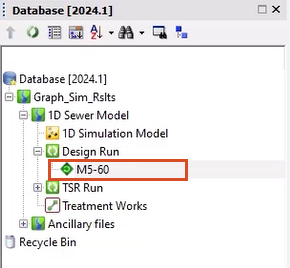
Start by graphing a single node in the simulation results.
![]()

The graph appears, displaying level properties of the node throughout the replay results. Notice the Ground Level line. Anything above this line indicates flooding.
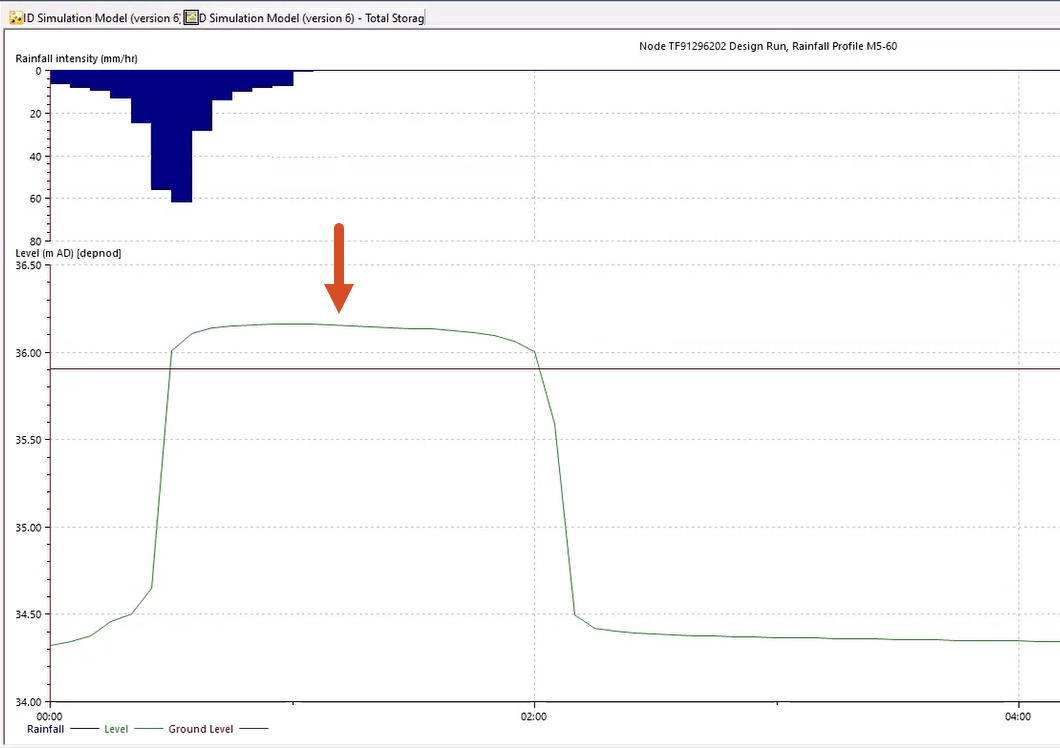
To graph several objects at once:
Select what to view in the results graph:
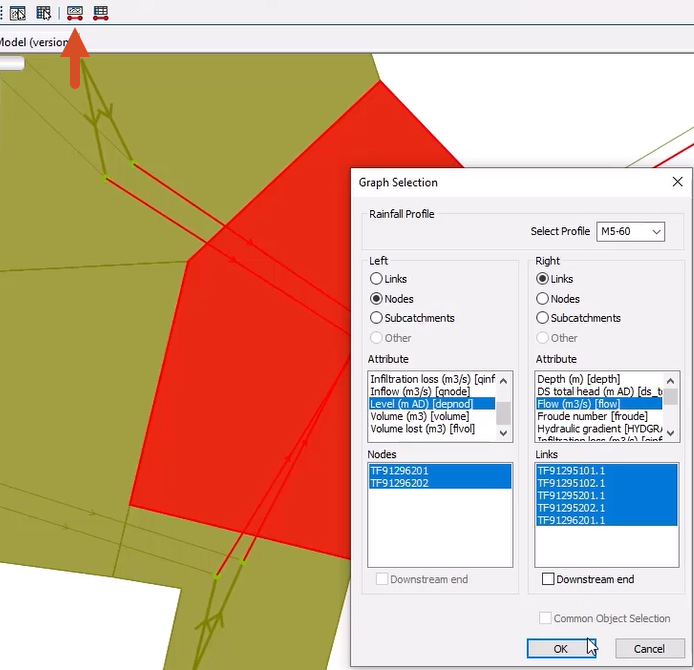
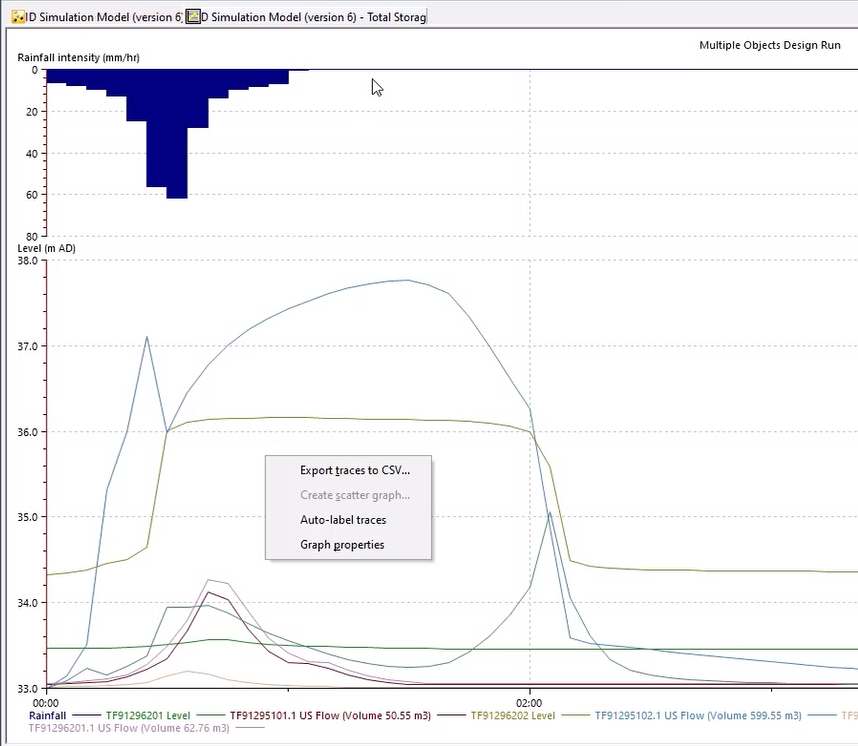
A graph report is a more advanced form of graphing and allows for comparing results, either from multiple locations or from multiple simulations.
To create a graph report:

A Locations popup appears, displaying the selected simulation and selection list.

To adjust the color and style of the lines:
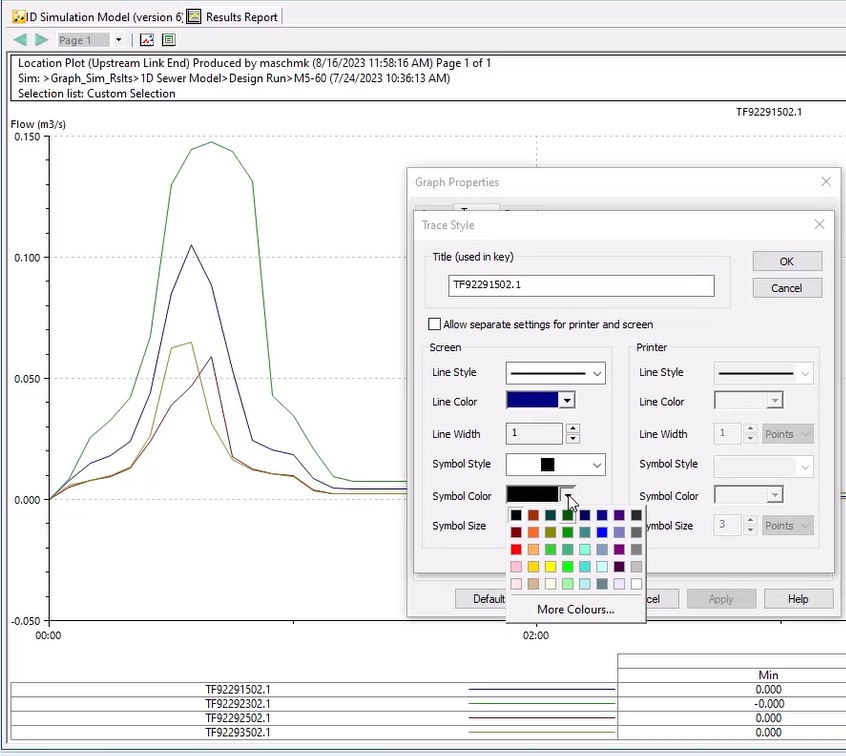
It is also possible to create more flexible custom graphs and then save them to the model group for future use.
With these selections active, create a selection list:
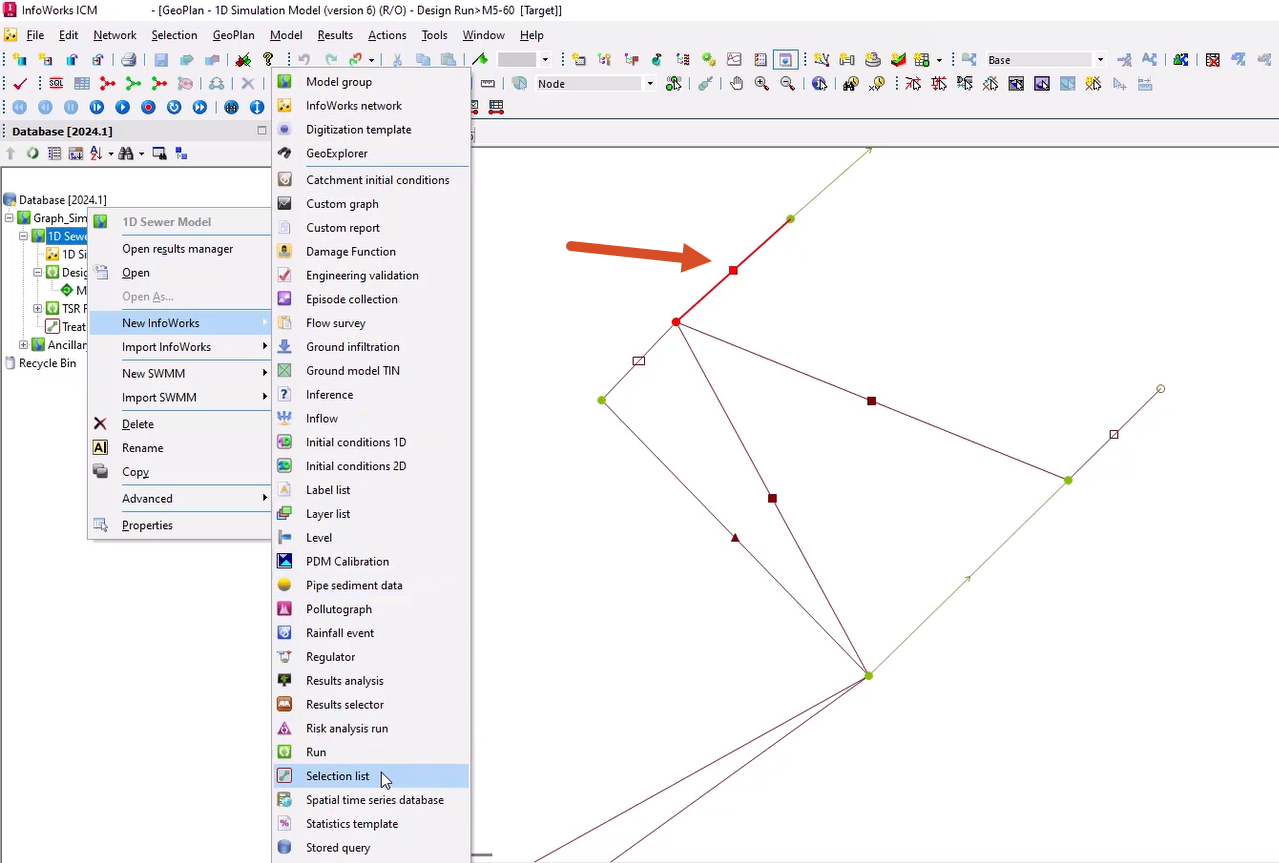
Note: This is a static selection set and does not change based on the timestep.
Now create a custom graph report for this selection:
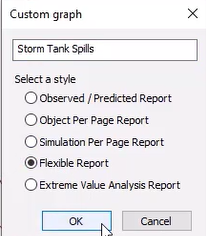
In the second row:
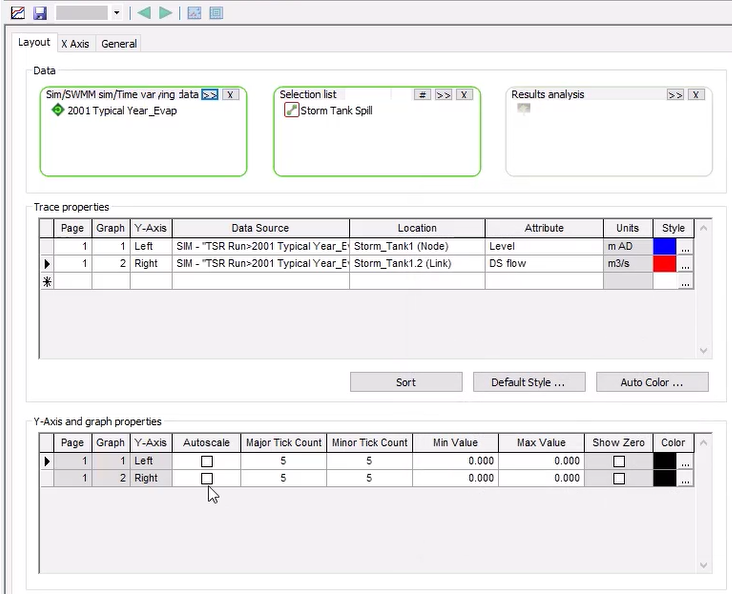
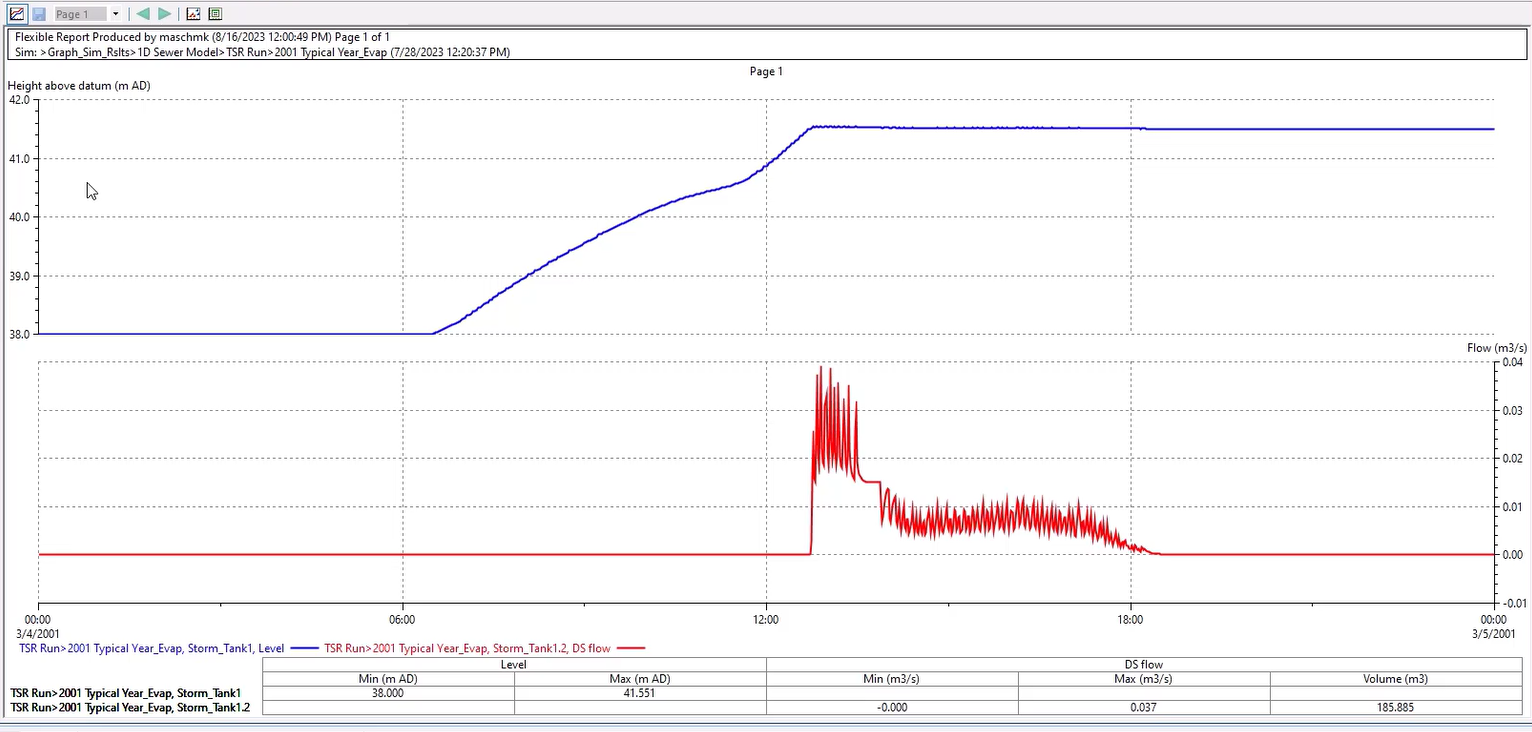
How to buy
Privacy | Do not sell or share my personal information | Cookie preferences | Report noncompliance | Terms of use | Legal | © 2025 Autodesk Inc. All rights reserved
Sign in for the best experience
Save your progress
Get access to courses
Receive personalized recommendations
May we collect and use your data?
Learn more about the Third Party Services we use and our Privacy Statement.May we collect and use your data to tailor your experience?
Explore the benefits of a customized experience by managing your privacy settings for this site or visit our Privacy Statement to learn more about your options.